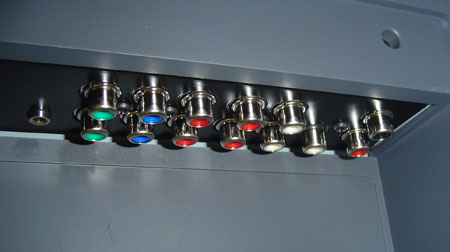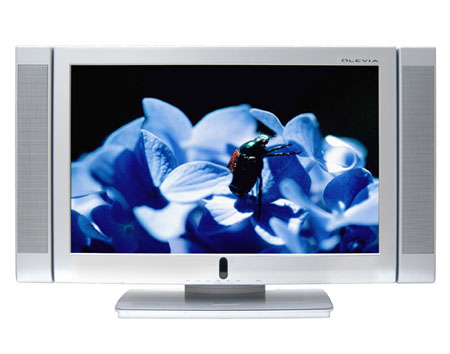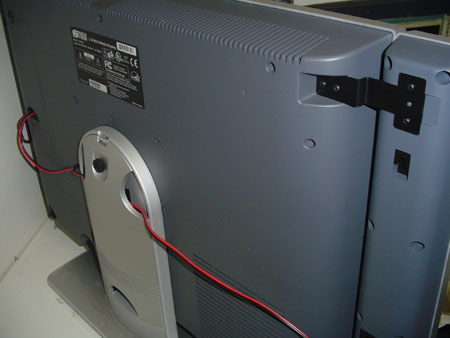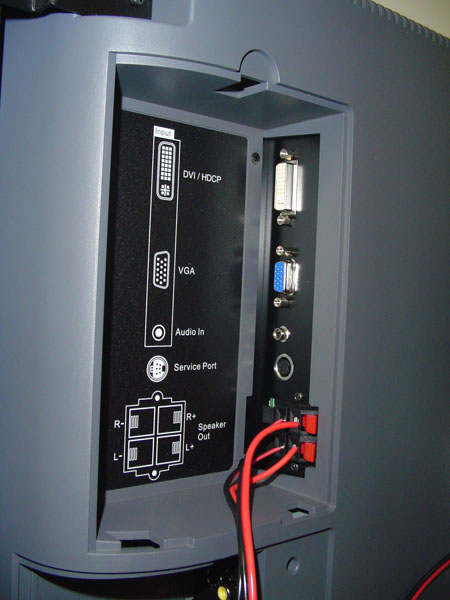Syntax Olevia 30" LCD: Cheap, Robust and Exceptional
by Kristopher Kubicki on June 30, 2004 12:00 AM EST- Posted in
- Displays
Introduction
We were excited to take a first look at Albatron's 30" LCD TV, a CE device that also is aimed to please the ultra high end PC enthusiasts. Unfortunately, the monitor was plagued with problems including scaling and resolution issues. However, a new company approached us several weeks ago with a new LCD based on the same panel as the Albatron LWX-30. Knowing that the majority of the flaws in the Albatron LCD were in the signal processors, and not the panel, we took a chance to see what Syntax could offer.At first glance, the Syntax Olevia and Albatron/Monivision LWX-30 are aesthetically very similar. After a few minutes though, it becomes clear that the Syntax unit is actually much cleaner and elegant in design. The monitor blends plastic, brushed aluminum, steel and acrylic.
Cable management behind the Olevia LT-30 was excellent. Removable panels allow us to string cabling behind, underneath or around any components in the rear of the unit. Below, you can see that the panels are attached by oversized plastic thumb screws.
The LCD had two component inputs, one set of composite and S-Video inputs, a coaxial TV tuner input, and digital and analog connectors. A key feature of the component and tuner inputs is that they are modular. What's good about these two modules on the LCD is that Syntax or end users can replace them without having to replace the entire panel or subsystems. Although it may not affect consumers in the long run, Syntax has the option of switching the analog TV tuner for something more capable in the future, without retooling the entire unit.

Component Inputs
Click to enlarge.













21 Comments
View All Comments
Swaid - Thursday, July 1, 2004 - link
K, got it...what I found from Digital Display Work Group (www.ddwg.org)
Dual Link
Dual Link DVI supports 2x165 MHz (2048x1536 at 60 Hz, 1920x1080 at 85 Hz). A dual link implementation utilizes all 24 of the available pins.
Single Link
Single Link DVI supports a maximum bandwidth of 165 MHz (1920x1080 at 60 Hz, 1280x1024 at 85Hz). A single link implementation utilizes 12 of the 24 available pins.
Souka - Thursday, July 1, 2004 - link
1280x768 native? Too low rez...my 19" is at that rez.TallCoolOne - Thursday, July 1, 2004 - link
Apple Dual-Link version of the nVidia 6800 is also exclusive to the PowerMac G5, so there's another $2000 or so needed to run the Apple 30"....I'm sure this technology will come to the PC _very_ soon, and will also require serious video card muscle to run at such high resolutions. For that reason, I don't see the same requirement on a Mac as a fair basis of criticism.
PrinceGaz - Thursday, July 1, 2004 - link
#14- the Apple display requires a Dual-Link DVI connection because Single-Link DVI isn't capable of a 2560x1600 resolution.Single-Link DVI only has 165MHz bandwidth which means a maximum resolution of 1920x1080 or 1600x1280 at a refresh-rate of 60hz. By using Dual-Link you get double the bandwidth which allows for double the resolution -- 2560x1600 is exactly double 1600x1280.
Neekotin - Thursday, July 1, 2004 - link
hey kris, is it really that good? ive been shopping for the dell 20' lately and now this.. your making my headache..Swaid - Thursday, July 1, 2004 - link
#15Awsome!
KristopherKubicki - Thursday, July 1, 2004 - link
Working on the Apple LCD and the Philips 1920x1080 LCD also.Kristopher
Swaid - Wednesday, June 30, 2004 - link
Has anyone seen reviews of the 30" Apple LCD display yet? The claimed 16ms response times sound very interesting for a 30" LCD...Actually it sounds like its 2 LCD panels put together since it needs a card capable of dual DVI output... Interesting!
Anandtech needs to review this ASAP! :D
WileCoyote - Wednesday, June 30, 2004 - link
Wow, it's a LCD review and the manufacturer isn't Samsung! Remember this moment, they don't come very often at Anandtech.Dagar - Wednesday, June 30, 2004 - link
Does the TV supply EDID to the PC via DVI?